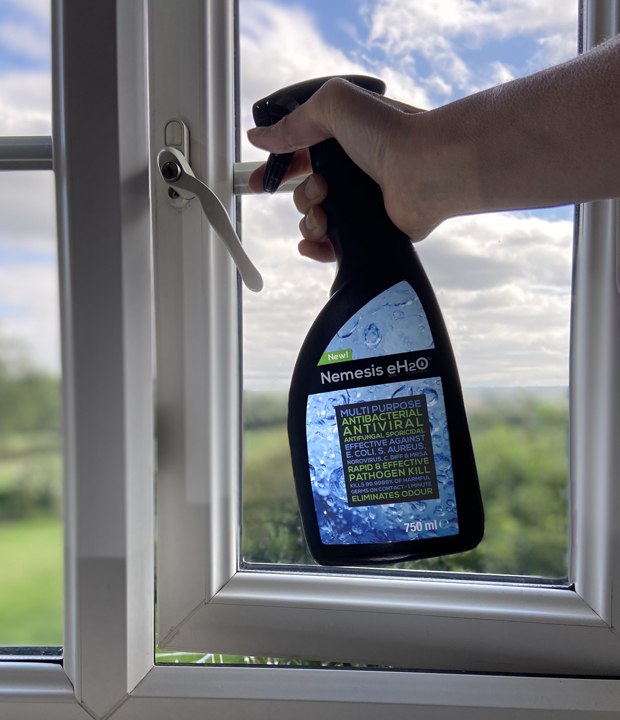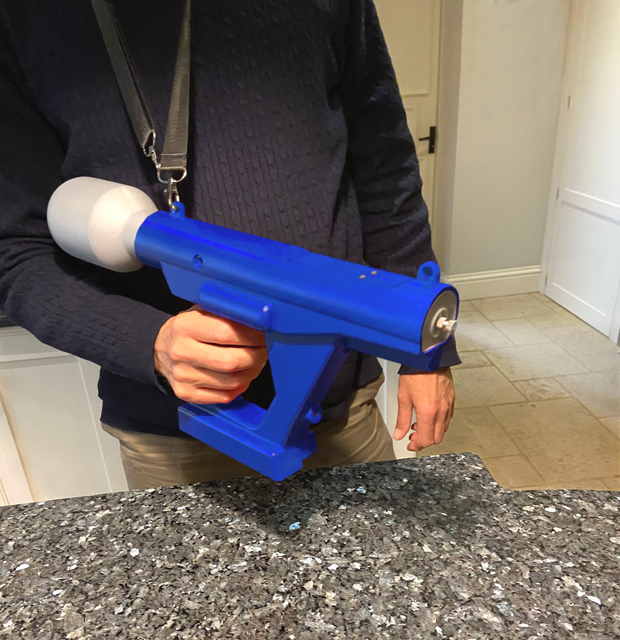 By Adrian Gee-Turner, Director, L’Eau Ltd
By Adrian Gee-Turner, Director, L’Eau Ltd
The pandemic forced cleaning businesses to expand their range of services to fulfil a vital role in the fight against COVID-19. Many cleaning companies already offered disinfection, and when the pandemic hit, the industry ramped up its services in response to overwhelming demand. However, now that the pandemic has subsided, this is a good time to step back and review our disinfection procedures. Are we using the right disinfectants? are they being applied correctly? and do we really need all those plastic bottles?
Disinfectant resistance
An issue that is starting to emerge is the microbial development of resistance to disinfectants, which may arise for a number of reasons. Microorganisms may reside in dirt, in difficult to access places and in biofilms, where disinfectants cannot reach easily. Here, at the margins of the disinfected area, microorganisms are exposed to lower disinfectant concentrations enabling less susceptible strains to survive. Cleaning operations should therefore take place before disinfection. Equally, if disinfectants are not applied properly, spray droplets that are not fully covering a surface for example, the margins with low concentrations are dramatically increased. Also, some disinfectants are persistent in the environment; presenting microbes with ineffective concentrations that encourage resistance. The ideal disinfectant is therefore one which is highly effective at the point of application, is applied correctly, and quickly loses all of its efficacy in the environment, before reaching sewers, drains and surface waters.
In order to ensure that a disinfectant is highly effective, we recommend that it should be certified to deliver a Log-4 kill of viruses. This highlights the importance of choosing the right disinfectant.
Bleach is effective at killing bacteria, fungus and viruses, but as an irritant to skin, it can cause burns and serious damage to eyes. Inhalation of its fumes can harm the respiratory tract, and the correct concentration of bleach must be used to achieve effective disinfection. Most bleach manufacturers claim 99.9% kill (Log-3) of harmful micro-organisms, so a Log-6 disinfectant is one thousand times more effective. This means that bleach could be expected (in the right conditions) to reduce 1 million colony forming bacterial units (CFUs) to 1,000 CFUs whereas a Log-6 disinfectant would be expected to reduce the same size colony down to just one single CFU. Bleach is therefore mainly suitable for the low-cost disinfection of non-porous, unpainted surfaces such as floors and toilets.
The expression ‘99.9% kill’ is used by many disinfectant manufacturers, but as highlighted above, whilst this might sound highly effective, it isn’t. Unfortunately, this situation is further complicated by the microbe to which the Log number relates. This is because some microbes are easier to kill than others, so beware of manufacturers that only offer 99.9% (Log-3) for bacteria. For comparison, the highly effective Nemesis eH2O (HOCl) delivers Log-6 effectivity against bacteria, Log-4 against viruses and Log-3 against spore-forming bacteria.
A further advantage of HOCl (and of bleach, incidentally) is that it rapidly degrades to salt and water after application, so it is not persistent in the environment.

Plastic bottles
We are major users of single-use plastics. As a consequence, our industry is a major contributor to this ongoing global catastrophe, so we have to ask ourselves if we are happy for this to continue? The use of plastic bottles should be minimised, and they should be returned to manufacturers for re-use.
Better disinfection strategy required in healthcare
The threat from hospital acquired infections (HAI’s) remains, and of course this now includes COVID. According to the World Health Organization (WHO), out of every 100 patients in acute-care hospitals, seven patients in high-income countries and 15 patients in low- and middle-income countries will acquire at least one HAI during their hospital stay, and on average, 1 in every 10 affected patients will die from their HAI.
The COVID-19 pandemic highlighted the extent to which health care settings can contribute to the spread of infections; harming patients, health workers and visitors if insufficient attention is paid to infection prevention and control (IPC). In a recent report (1), the WHO showed that where good IPC practices are followed, 70% of those infections can be prevented.
Why are we still using Quats?
In the past, Quats were popular because they provided an opportunity to formulate disinfectants to target specific pathogens in specific applications, especially where detergent action is also required. However, as outlined above, cleaning operations should take place prior to disinfection.
The continued use of Quats within the cleaning industry continues to raise significant concerns. Their activity, for example, can be adversely affected by water hardness (during dilution), fat-containing substances, and anionic surfactants. In addition, cotton and gauze may absorb the active ingredients of Quat based products and significantly reduce their effectiveness. Many cleaning and disinfection products containing Quats are potentially hazardous to health, and product labels contain warnings against ingestion, or exposure to skin, eyes and the respiratory system. These products are frequently supplied in concentrated form, which presents a greater hazard and provides opportunities for mixing errors which may affect efficacy.
The health effects of Quats include a range of problems from mild skin and respiratory irritation up to severe caustic burns on skin and the gastrointestinal wall (depending on concentration). Quats have also been associated with allergies and occupational asthma, and with fertility and birth defects in laboratory mice.
Given the potential health effects of Quats, the group most at risk are those of us that work with cleaning chemicals every day. A Paper published in the American Journal of Respiratory and Critical Care Medicine (2), involving 6,235 participants over 20 years, concluded: Women cleaning at home or working as occupational cleaners had accelerated decline in lung function, suggesting that exposures related to cleaning activities may constitute a risk to long-term respiratory health.
The Quat disinfectants that contain hazardous substances also represent a threat to the environment and used containers should be incinerated or disposed of in an acceptable permitted waste disposal facility.
Quats entered the market in the early 20th century before the US EPA began regulating the manufacture and sale of potentially harmful chemicals under the 1976 Toxic Substances Control Act. As a result, Quats counted as existing chemicals on the market that could continue being included in consumer products without being evaluated for safety. However, these compounds have since been extensively tested and their precautionary statements are available under the sections on Environmental Hazards, and Danger to Human Health within their registration documents on the US EPA website.
Post-pandemic, there will inevitably be a greater demand for improved disinfection procedures and most cleaning companies now include this in their services. However, if going back to normal means using these hazardous chemicals, maybe we should take this opportunity re-assess the health and environmental impacts of the products that we use?
Health and safety regulations
Under the Workplace (Health Safety and Welfare) Regulations 1992, employers have a legal duty to ensure, so far as is reasonably practicable, the health, safety and welfare of employees. Furthermore, the Management of Health and Safety at Work Regulations 1999 require employers to assess and control risks to protect their employees. A key element of this is the requirement to comply with the COSHH Regulations. The COSSH Regulations include dust, mist, vapour, fumes and chemicals. In addition to their health and environmental risks, hazardous cleaning and disinfection chemicals therefore also incur an additional administrative burden.
In many countries, employers are duty bound to consider the health and safety of their staff during the journey to work. Whilst this is not the case in the UK, responsible organisations should consider doings so.
The way forward
Potential problems occur when facility managers dictate cleaning schedules and products without the requisite training and experience. It is vitally important therefore that the trained professionals in the cleaning industry are involved in these important decisions because of the health implications for staff, visitors and cleaning staff. We do not tell electricians how to carry out their work, because we know that they must adhere to regulations; the cleaning industry should be the same, without appropriate standards, how can anyone produce a reliable risk assessment?
The solution lies in the use of environmentally friendly products that are not hazardous to human health. However, it is vitally important that these products are as effective, or better, than the hazardous chemicals that they replace. For these reasons, hypochlorous acid (HOCl) and catholyte have become increasingly popular in the healthcare, education and facilities management sectors.
Hypochlorous acid is produced naturally by our white cells to fight infections, and it is now available as a commercial product in a stable form. With a log 6 reduction, HOCl has been shown to be one of the most effective products available, and it poses no danger to humans, pets and the environment, with no PPE required.
Conscious of the need to ensure effective coverage during disinfection, L’Eau Limited has been working with the cleaning company Twotwenty2 Limited to develop a UK-designed electrostatic sprayer, and in doing so we sought the most effective HOCl product. Following extensive research and evaluation, we chose Nemesis eH2O (500 ppm), because not all HOCL products are as effective and as stable when stored.
Electrostatic sprayers should form part of all cleaning companies’ tool kit because they dramatically improve the coverage of disinfection and improve the treatment of difficult-to-access areas. All cleaning should be followed by sanitising with electrostatic sprayers, because this method maximises coverage and leaves viruses and other pathogens with no place to hide. By implementing standard procedures that ensure dwell times and coverage of all surfaces, we can create a safe environment.

We cannot wait for the government to change the way we operate; we owe it to our work colleagues, our customers, our children and our planet to stop using hazardous chemicals and choose a clean, safe, effective alternative. The cleaning industry includes professional, dedicated, hard-working staff that perform a vital role in society. We are the people that understand the implications of cleaning and disinfection chemical choices, so we are the ones who will lead the way; showing others the best way forward – we simply must take this opportunity to ensure that our disinfection procedures and materials are as effective as possible.
References
1. WHO launches first ever global report on infection prevention and control. www.who.int/news/item/06-05-2022-who-launches-first-ever-global-report-on-infection-prevention-and-control
2. Cleaning at Home and at Work in Relation to Lung Function Decline and Airway Obstruction. https://www.atsjournals.org/doi/full/10.1164/rccm.201706-1311OC
3. Do we know enough about the safety of quat disinfectants? Chemical & Engineering News. https://cen.acs.org/safety/consumer-safety/know-enough-safety-quat-disinfectants/98/i30




